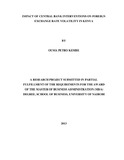| dc.description.abstract | This study explored the impact of central bank intervention on foreign exchange rate volatility in Kenya. The central banks have undertaken an unprecedented number of both coordinated and unilateral intervention operations in the last 10 years. Existing empirical evidence on the effectiveness of intervention is mixed: studies using data from the 1970s suggest that intervention operations that do not affect the monetary base have, at most, a short-lived influence on exchange rates, but more recent studies indicate that the intervention operations that influenced both the level and variance of exchange rates. This paper examines the impact of central bank intervention on the volatility of the US Dollar, Euros, and Sterling Pounds against Kenya Shilling in Kenya over the period of 2008 and 2011.
Secondary data were collected from the CBK and analyzed using analysis of variance. The results indicate that intervention operations generally reduce exchange rate volatility. This is particularly true of interventions that are made with the notification of the public. The results have also shown that the impact of the CBK intervention is felt in the market immediately and that CBK only intervene to calm disorderly market.
Given the conclusion, the market, including the central bank, the banking sector and the corporate sectors, ought to develop hedging instruments to minimize speculative tendencies prevalent in the foreign exchange market and the need of the central bank to intervene to smooth out the wide fluctuation in the exchange rate. This would minimize the misalignments in the exchange rates from its fundamental levels, caused by both speculation and central bank intervention this would be supplemented with the development of the domestic securities market geared at reducing liquidity to make the market more sensitive to changes in the central bank policy rates. | en |

